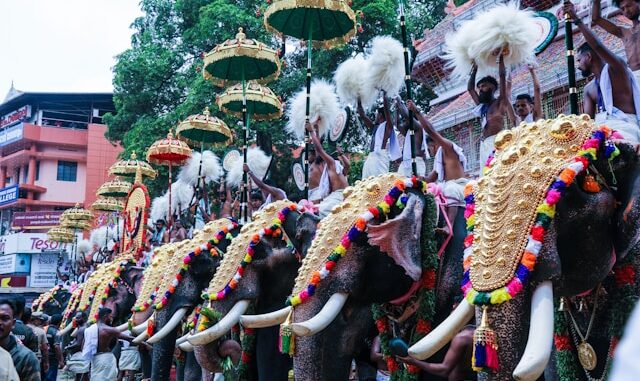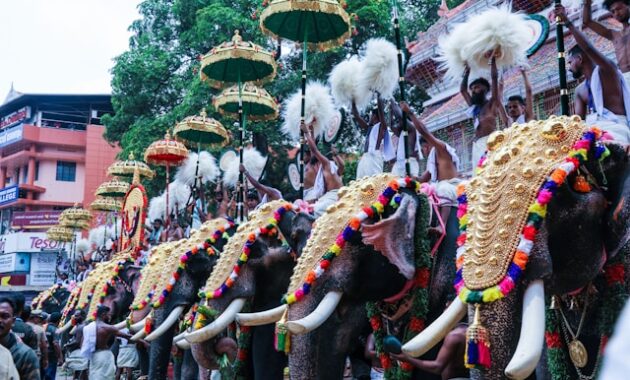
Thrissur Pooram, often hailed as the “Mother of All Poorams,” is an awe-inspiring temple festival held in the cultural capital of Kerala—Thrissur. Taking place annually in the Malayalam month of Medam (April-May), this grand spectacle is not just a religious event but a vibrant cultural experience that attracts thousands of domestic and international visitors alike. Rooted deeply in Hindu tradition, yet widely appreciated across cultures and religions, Thrissur Pooram is a visual and auditory extravaganza that showcases Kerala’s rich heritage.
Historical Significance and Origins
Initiated by Sakthan Thampuran, the erstwhile ruler of the Kingdom of Cochin, in the late 18th century, the Thrissur Pooram was conceived as a unifying event for all the temples in and around Thrissur. Previously, temples that missed the annual Arattupuzha Pooram due to delays were not allowed to participate. Sakthan Thampuran’s visionary leadership led to the creation of a festival where temples within a 10 km radius of the Vadakkunnathan Templewould unite in a harmonious display of devotion, culture, and competitive spirit.
The Venue: Vadakkunnathan Temple Grounds
At the heart of this majestic celebration lies the Vadakkunnathan Temple, a classic example of Keralite temple architecture, dedicated to Lord Shiva. This temple, located on a hillock in central Thrissur, forms the epicenter of the festivities. Although non-Hindus are not allowed inside the temple premises, the festival itself takes place in the surrounding Thekkinkadu Maidan, a sprawling open ground that becomes the canvas for a week-long cultural explosion.
Spectacular Elephant Processions: A Majestic Display

One of the most iconic aspects of Thrissur Pooram is the parade of caparisoned elephants. Two main groups—the Paramekkavu and Thiruvambady Devaswoms—lead the procession with 15 elephants each, adorned in glittering nettipattams (forehead decorations), charming parasols, and other golden ornaments. The synchronized display of decorated elephants, known as Kudamattom, is the centerpiece of the celebration. Each side competes in showcasing the most ornate and creative umbrellas, switching them rapidly to the beat of traditional Panchavadyam and Melamensembles.
Traditional Music: The Pulse of the Festival
The rhythmic brilliance of Panchavadyam, an orchestration of five instruments—Thimila, Maddalam, Ilathalam, Kombu, and Edakka—forms the sonic backbone of the festival. These performances build from slow, measured beats to a climactic crescendo, energizing the crowd with an almost spiritual fervor. The Ilanjithara Melam, performed near the western entrance of the temple, is among the largest gatherings of percussion artists anywhere in the world.
Fireworks Display: A Nighttime Spectacle
The Vedikettu or fireworks show during Thrissur Pooram is an unforgettable spectacle that lights up the skies in the early hours of the morning. The display features massive pyrotechnic structures and complex patterns that have been prepared over several months. The sheer intensity of light and sound draws thrill-seekers and photographers from across the globe. The main display typically happens after midnight and lasts several hours, captivating the audience till dawn.
Kodiyettam and Purappadu: Rituals that Set the Stage
The Kodiyettam, or flag hoisting ceremony, marks the official beginning of the festival. Each participating temple hoists its flag, signifying its entry into the Pooram. The Purappadu—the ceremonial departure of the deity’s idol from the temple—follows, accompanied by ritualistic drumming and festivities. These processions are not just religious obligations but are symbolic of unity, rhythm, and devotion.
Participation of the Poorams: An Ensemble of Temples
Apart from the two main players—Paramekkavu and Thiruvambady—several other temples participate in the festival, including Kanimangalam, Laloor, Ayyanthole, Neithilakkavu, and Panamukkampilly, among others. Each temple brings its own flavor to the event, contributing to a diverse yet unified cultural presentation. These smaller poorams often serve as a build-up to the main event, creating a crescendo of excitement.
Cultural Significance Beyond Religion
Thrissur Pooram is not confined to religious boundaries. It represents the cultural heartbeat of Kerala and brings together people of all faiths. Vendors, artisans, street performers, and food stalls create a vibrant bazaar-like atmosphere, while local businesses thrive during this peak tourism season. The event also encourages the preservation and promotion of traditional art forms, many of which would otherwise face extinction.
Sustainability and Safety Measures
In recent years, there has been a push for eco-friendly celebrations. Use of biodegradable materials, noise pollution limits, and safety protocols are now integrated into the festival’s organization. Efforts to digitize crowd management and use drone surveillance have also helped in ensuring a safe environment for lakhs of attendees.
When and How to Visit Thrissur Pooram
The festival usually falls in April or May, with dates varying according to the Malayalam calendar. If you’re planning to attend, it’s advisable to book accommodations well in advance. Thrissur is well connected by rail, road, and air—the nearest airport being Cochin International Airport, about 55 km away.
Make sure to experience:
- The Elephant procession at the Thekkinkadu Maidan
- The Kudamattom competition
- The early morning fireworks
- The Melam and Panchavadyam performances
- The cultural displays and street food stalls
Conclusion: Why Thrissur Pooram is a Must-Experience Event
More than a religious celebration, Thrissur Pooram is a living, breathing spectacle that celebrates Kerala’s artistic legacy, communal harmony, and unparalleled spirit. Whether you are a culture enthusiast, a photographer, or a spiritual seeker, this festival promises an experience that is both soul-stirring and unforgettable.